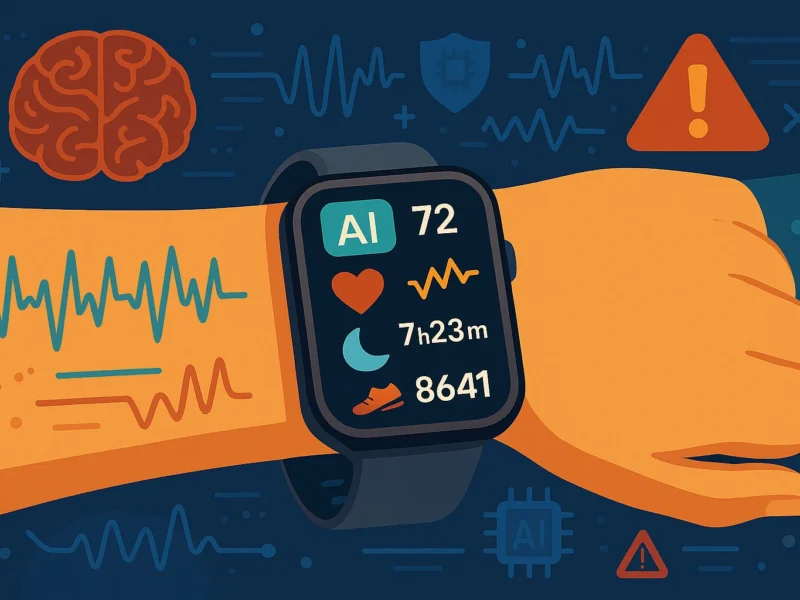The AI is on your wrist (even if you don't know)
Who has never heard of the smartwatch? More and more people are wearing on the wrist, a tiny device that can monitor heartbeat, sleep, or stress levels. What few know, however, is that behind the “simple” interface is often hides an artificial intelligence engine that analyzes, learns and decides in real-time. And this is also true for bracelets fitness, glasses, smart, bands, postural, rings biometric and other gadgets wearable.
What are wearable devices smart
The wearable, or wearable devices, these technologies are designed to be worn on the body and interact constantly with the people using them. Thanks to advanced sensors, to collect biometric data and the environment: heart rate, breathing, movement, temperature, brain activity, and quality of sleep. But to make them truly “smart” is artificial intelligence, which transforms this data into personalized tips, predictions, predictive, or alert in real-time.
It is not only to “record” data, but to interpret them. The difference between a balance of classic and smart is the same one that passes between a journal and a digital assistant.
Artificial intelligence and wearable computers: an inseparable couple
The artificial intelligence in wearable devices acts on multiple levels. First of all, it collects huge amounts of data (big data personal), then processes them in the form of models of machine learning. So, for example, an algorithm can recognize if you're sleeping badly, and suggest to change the routine in the evening. Or you may notice an irregularity in the heartbeat and recommend a visit to the doctor.
In clinical settings, the wearable AI are already being used to monitor chronic diseases, such as diabetes or cardiovascular disease, providing ongoing support and reducing hospitalizations (Mayo Clinic).
In the world of sport, the combination OF + wearable allows you to optimize the training on the basis of the biological response of the athlete. Not surprisingly, many professional teams depend on wearable technology with built-in artificial intelligence.
Wellness under control... or under surveillance?
But there is a downside to this. The increasing popularity of devices that collect data so sensitive – health, habits, emotions – raises profound questions. Who has access to this information? Where are they stored? Can be used against us?
The border between monitoring for the well-being and monitoring invasive is thin. And if the devices are integrated in a business environment or insurance, the risk that they become tools of control is real. Some companies, for example, to offer rewards to employees who monitor your sleep. But this means, implicitly, that those who sleep “evil” to be penalized?
Are the same questions that we have already dealt with in the article on IA and Privacy Digital: Navigate the Challenges of the Era of Algorithmic and that come back every time that we talk about Surveillance and Artificial Intelligence: Who Watches the Watchers?
Biometric data, and vulnerability invisible
Another weakness is represented by the cyber security. The wearable devices, they often communicate via Bluetooth or Wi-Fi and can become easy targets for hackers. It is not science fiction: in the past, have already been documented cases of violations of smartwatch and fitness trackerWired).
In addition, the biometric data are not just numbers. They are a unique, non-changeable, and could potentially be used to identify and manipulate individual behavior. Think of the risk that the app suggests content or decisions on the basis of our state of mind detected in real-time.
Towards a balance between technology and rights
It is important, therefore, to develop a culture that is critical to these technologies. The benefits are obvious: preventive health care, continuous care, personal wellness. But should be balanced with respect for the privacy and the transparency of the algorithms, the right to disconnect.
In Europe, the new TO Act and the GDPR and provide a framework for protection, but there are large margins of ambiguities and gaps in the regulatory, mainly outside the EU. It is important that the manufacturers of wearable devices adopt high ethical standards, and ensure safety by design.
We close this reflection, raising another useful: Ethics of Artificial Intelligence: Why it concerns us all
Frequently asked questions (FAQ)
The wearable devices are really reliable?
Depends on the model and the scope of use. Some medical devices are certified and tested, while others focus purely indicative. It's always good to compare the data with a doctor.
How can i protect my biometric data?
Choose devices that provide data encryption, avoid sharing information with the app for the unknown and check the privacy settings.
The AI can diagnose diseases through wearable?
In some cases, yes. Some algorithms are able to identify early signs of diseases, but can never replace medical advice.
Conclusion: wearable technology, awareness to cultivate
The wearable devices with AI are revolutionizing our relationship with the body, the health and well-being. But as with all technologies, also pose new challenges. It is up to us to learn how to use them with intelligence: not only artificial, but also the human.
In the near future we will see wearable increasingly discrete, accurate, and adaptive. But the real innovation will be cultural: learning to live with the tools that we are familiar with, without losing the control over who we really are.
